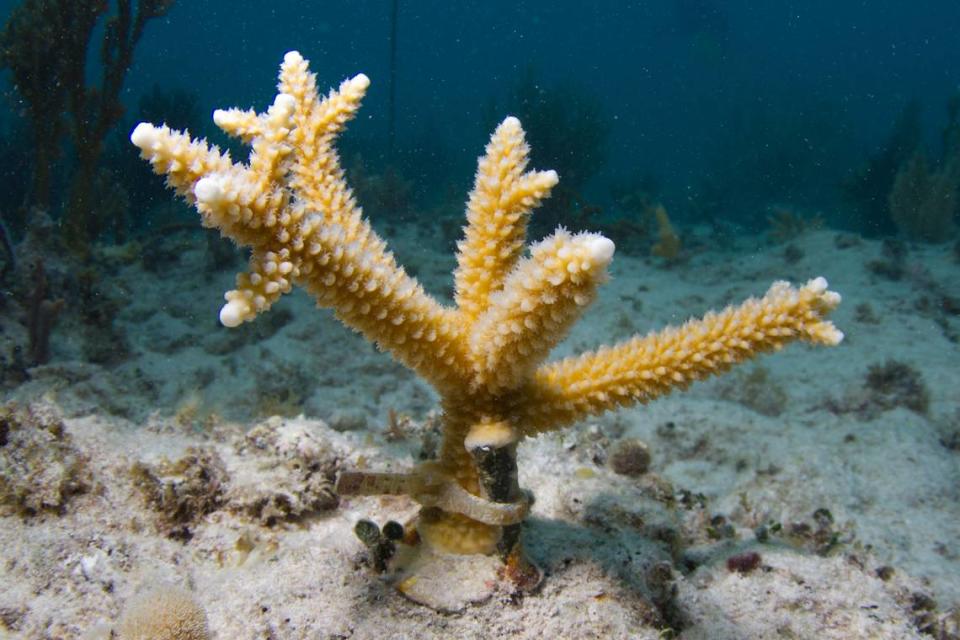Here’s how coral restoration groups in Miami and the Keys help revive blighted reefs
The Coral Restoration Foundation, which is based in Tavernier and Key Largo in the Florida Keys, was founded in 2007 in response to the widespread loss of the two main reef-building coral species, staghorn and elkhorn corals.
“We’ve lost around 97% of the population of those two species in the last 30 years,” says Alice Grainger, the foundation’s communications director. “The situation is pretty dire.”
Much of that loss is attributed to disease, bleaching from rising temperatures, hurricanes and even from people anchoring their boats on the reefs.
Since the nonprofit’s inception, it has returned more than 130,000 staghorn and elkhorn corals to reefs in the Keys and has restored an area of 107,639 square feet of reef.
“It’s the largest restoration program in the world,” Grainger says.
The nonprofit’s seven coral nurseries in the Keys produce more than 40,000 corals every year.
“We actually can’t outplant as many corals as we can grow,” says Grainger, in what she says is a bit of a good problem. “We’ve become the experts at growing corals.”
Grainger says that elkhorn and staghorn corals are so important because they provide homes for other reef organisms to live in.
“These are the corals that create this complex habitat that’s critical for underpinning the ecosystem that people rely on for fishing and tourism. They’re also relatively fast-growing,” she says.
CRF invented Coral Trees, made from a PVC design that the organization developed that allows extensive numbers of coral fragments to grow in large, offshore nurseries. It’s now being used by groups all over the world.
“We hang coral fragments on these trees and because the corals are suspended in the water column, they’ve got 360-degrees of access to nutrients and some sunlight. They’re away from predators and from sedimentation. We can raise and lower the trees depending on the water temperature,” says Grainger.
CRF is working with the National Oceanic and Atmospheric Administration (NOAA) in an ambitious project called Mission: Iconic Reefs, to restore seven iconic reefs in the Florida Keys for a total of 1,001,043 square feet over the next 20 years.
“Everything that we do relies on donations, grants and sponsorships,” Grainger says. “The funding that we get from the public allows us to invest in every aspect of our work. Plus this goal of 93,000 square meters of reef restored in the next 20 years is a massive goal but it’s very achievable.”
Grainger says the dollar value for the project is $100 million.
Corals reproduce in two ways: asexually (through fragmentation) and sexually.
A big focus of the work CRF is doing is to restore genetic diversity to the reef.
“This is a critical component in any ecosystem – it needs to be genetically diverse,” says Grainger.
“The corals that we’re working with, we started collecting from the wild in 2007,” says Grainger.
“They’re already pretty hardy because they are the survivors. The offspring are likely even more resilient. The diversity component is really critical,” she says. “We’re essentially banking genetic material that is disappearing throughout the Keys,” she adds.
Grainger says that CRF is looking at establishing a nursery in Broward County that houses specific genetic strains of these corals.
CRF also offers education components, such as presentations at schools, workshops, after-school clubs and recreational dive programs where divers help in restoring reefs.

The University of Miami Rosenstiel School’s ‘Rescue a Reef’ Program
Professor Diego Lirman of the University of Miami’s Rosenstiel School heads the “Rescue a Reef” program, which also aims to restore threatened corals, namely staghorn corals. The nonprofit combines scientific research on coral restoration with equipping citizen scientist divers to help rebuild coral reefs in Miami-Dade, from Sunny Isles Beach to Elliott Key, which is within Biscayne National Park.
“For about 12 years, we’ve been focusing on active restoration – that means growing corals in nurseries and then planting them onto depleted reefs,” says Lirman of the University of Miami’s Benthic Ecology and Coral Restoration Lab.
“Coral restoration is a slow process because you need to collect each coral from your nursery and then plant them individually onto the reef,” he says.
“My lab along with other collaborators in Florida, developed the first regional coral reef restoration program in the world,” he says. “We established the first coral nurseries under water, where we would propagate corals that we would later use for restoration.”
Like the “good problem” that CRF had, Lirman and his team had too many corals, and not enough time or resources to plant them. They decided to get the community involved via citizen science to aid in restoration efforts.
Hence, five years ago, UM’s “Rescue a Reef” program was born.
“The public, through citizen science, is a great way to not only help our program plant more corals but also to engage the local public in restoration and hands-on learning opportunities,” says Lirman.
The Rescue a Reef Citizen Science Program started in collaboration with Diver’s Paradise in Key Biscayne. The partnership led to an education program and citizen science expeditions, which is the centerpiece of “Rescue a Reef.”

To help
The Coral Restoration Foundation
www.coralrestoration.org
Headquarters: 89111 Overseas Hwy, Tavernier, Florida 33070
Exploration Center: 5 Seagate Blvd, Key Largo, Florida 33037
Phone: 305- 453-7030
info@coralrestoration.org
UM’s Rescue a Reef Program
www.rescueareef.rsmas.miami.edu
4600 Rickenbacker Causeway, Miami, FL 33149
Phone: (305) 421-4209
rescueareef@gmail.com

